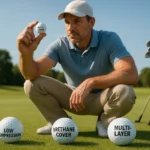
A golf ball marker is a small, flattened object used to mark the position of a golf ball when the ball is lifted on the putting green.
It will enable the player to raise their ball without fear of losing their position and guarantee a fair game played in accordance with the rules. They are generally small and lightweight and can be made out of a variety of sizes, shapes, and materials.
Using a marker the right way is part of golf etiquette. It helps avoid confusion among players.
Plenty of golfers personalise their markers, adding some identity to this simple piece of gear. Knowing how and when to use a ball marker can really boost your focus and show respect for the game.
Table of Contents
Understanding the Key Functions and Purposes of Ball Markers
Key Functions and Purposes
The purpose of a golf ball marker is to demonstrate where a player’s ball was before it was picked up.
This makes the ball return to its actual position. Players typically mark a golf ball to clean it and let another player putt without distraction or if the ball is in the other person’s line of play.
Golf ball markers help ensure the game will be played fairly by allowing desirable accuracy and making it so that an inadvertent nudge of the ball or closure alike on its original place is not a reason for regret.
And they don’t incur a penalty for playing the ball from the wrong spot. Tracking the ball’s spot is key because a minor variation can determine whether or not a putt falls.
Rules and Etiquette for Ball Marking
Under the official golf rules, a player is supposed to mark the ball when on the green before picking it up unless there is natural movement. The marker is placed just behind the ball. The ball shall not be put in play on a different spot until it is replaced at the original spot.
Proper use of a marker is part of the etiquette of golf. Players shall not cause undue delay in marking time. They’re also forced not to mark on something misleadingly or in their favour. The putter must be returned and the marker removed before the ball is putted.
Key Rules for Ball Marking
- Mark before lifting: You should always mark your ball directly behind it before you lift it.
- Avoid slow play: Be prepared to mark fast so as not to hold up the group.
- No unfair marks: Don’t hit your competitor’s marker or your own after a revolution has been determined.
- Remove the marker: always remove the marker when you are taking a putt.
- Respect others: Never touch or move another player’s marker without their permission.
- Place the ball precisely: the ball must return to the exact same place where it was before the game can proceed.
Types and Features of Golf Ball Markers

Popular Materials and Designs
Golf ball markers are often made of metal, plastic, wood, or leather. Metal markers, including those made of stainless steel and brass, are durable and often feature a polished finish. Plastic markers are lighter and are available in a variety of colours and patterns.
Can be used with wooden markers for an earthy look, but these markers may deteriorate faster. Leather markers are rarer but add a distinctive texture to the page.
Shapes can range from basic discs to coins or novelty designs.
Customisation Options
A lot of golfers use customised markers where the personal comes into play. Customisation can include:
- Initials or names
- Logos or club emblems
- Special colours or patterns
Personalised markers make it easy to find your ball when you spot the zebra. A few speciality markers also feature a magnetic system, so you can keep them on your hat clip when not in use. Others are multipurpose, like those designed to clean golf clubs.
Personalisation does not change the marker size or shape, which must conform to game rules.
Choosing the Right Marker for Your Game
When selecting a golf ball marker, its visibility as well as size should be taken into account. Bright or novelty markers are more visible on the green. Markers must be small enough for easy transport but large enough not to get confused.
A lighter marker minimises disruption when handling the device. Simple circles are classic and easy with simple aid or flat discs; magnets are simply convenient.
If you are one of those players who frequently wash or touch their marker. The perfect pick that finds a balance between utility and style so you can stay focused on the game and not your steeze.
Common Types And Features
| Type | Typical Material | Key Features | Best For |
|---|---|---|---|
| Coin Marker (Traditional) | Metal (Brass, Nickel, Zinc Alloy) | Small, thin, flat disk. Classic feel, durable, minimal interference. | Traditionalists, minimalists, players who prefer a low-profile mark. |
| Hat Clip / Magnetic | Metal, Plastic, Strong Magnet | Clips onto a hat brim or belt. Magnetic holder ensures the marker is always easily accessible. | Convenience, quick access, players who wear headwear often. |
| Divot Tool Combo | Stainless Steel, Aluminum | Multi-functional tool combining a marker (often magnetic) with a repair tool (prongs or switchblade). | Essentialists, multi-functional use, keeping pockets clear. |
| Putt-Line / Alignment | Plastic, Lightweight Metal | Features clear lines, arrows, or bubbles to aid in lining up a putt. Often larger surface area. | Precision putting, alignment focus, players who need visual aids. |
| Button Marker / Logo Ball | Plastic, Rubber, Large Metal | Larger diameter and thickness than a coin marker. High visibility and often heavily branded or personalized. | High visibility, ease of handling, personalization (logos/designs). |
| Poker Chip Marker (Heavy) | Ceramic, Heavy Plastic, Metal Core | Large size (40mm+ diameter), weighted feel for stability, highly visible, often features unique colors or textures. | Novelty/Gifting, high visibility from a distance, players who prefer a substantial, easy-to-handle item. |
| Micro Marker (Thin Disk) | Ultra-thin Metal (Titanium, Aluminum) | Extremely thin profile (often < 1mm) and minimal diameter, designed to sit nearly flush with the green. | Competitive play, minimizing interference with other players' putts, professional golfers. |

